NETWORK
The network is about access to the railways, the train paths. Optimal capacity utilisation requires far-sighted construction planning, fair prices and good organisation.
At present, seven infrastructure managers (IMs) in Switzerland operate their independent standard gauge networks at huge cost in terms of extra administrative work and loss of synergy. For this reason we call for a single standard gauge network for this country that’s also connected with the world beyond the border – just like the roads.
Timetables – i.e. the availability of train paths – are currently geared to rapid passenger transit and frequent stops for regional trains, all of which slows the average speed of freight trains. Rail path pricing also impacts the commercial interests of freight operators. That’s why we’re campaigning for rail freight to be split into two tariffs, A and B, depending on productivity and how long the freight spends in the network.
The fact that tracks are currently constructed primarily with passenger comfort and convenience in mind substantially increases the costs of building and maintenance. Here we call for more far-sighted planning and a more innovative approach to maintenance. When standards of passenger transit are raised, this should be offset by discounted charges for freight using the rail network. After all, switching yards are just as much part of the rail network’s responsibility as commuter train stations.
Read more about the topic in economiesuisse’s Infrastructure Report 2019 (in german).
Actors in the network sector
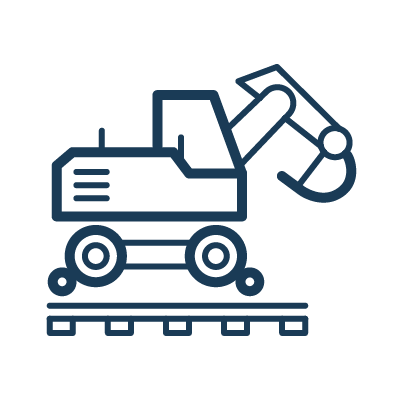
Track construction company

Engineering offices
Informative
Current construction site situation on the Swiss railway network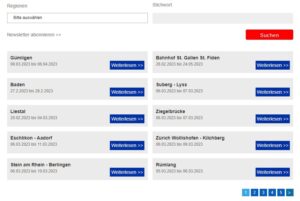
- A list of current construction sites on the Swiss railway network, as well as information about them, can be found under this link.
Perspective RAIL 2050
- VAP Hearing Response Perspective BAHN 2050, 10.10.2022 (in german)
- Questionnaire on the BAHN 2050 perspective, 14.10.2022 (in german)
- Information FOT on the Perspective RAIL 2050
Track access charges and network access
In the 2021 train path price revision and amendment of the Railway Network Access Ordinance, we advocated greater competitiveness for rail freight transport. To this end, we welcomed the planned relief for freight railways with an amount of CHF 30 million and the maintenance of the noise bonus. Documents on this can be found in the archive.
Ordinance on the Organisation of the Railway Infrastructure (OBI-VO)
- Ordinance on the Organisation of the Railway Infrastructure (OBI Ordinance) AS 2020 1915
Space, Transport, Environment 2050
- Sectoral plan for transport, part of the programme dated 20.10.2021
- VAP Hearing Response Sectoral Plan for Transport Programme Part 11.12.2020
- Documents Mobility and Space 2050 of the Office for Spatial Development, ARE
Sectoral plans, concepts, strategies
- Programme section of the sectoral plan for transport
- Spatial concept for Switzerland
- Freight transport by rail concept
- Agglomeration Transport Programme
- Transport hubs programme
Freight Transport 2030 Infrastructure
Infrastructure development
- Payment framework 2020–2023 National roads, cantons
- Payment framework 2020–2023 National roads, organisations
Railway infrastructure expansion
In the most recent package, the 2035 expansion step (ES 35), parliament approved investments of CHF 12.89 billion in 2019.
Strengthening passenger rights in public transport
Archive
Train path prices and network access
- Anhörung: Begleitschreiben BAV
- Anhörung: Entwurf Eisenbahn-Netzzugansverordnugn (NZV)
- Anhörung: Verordnung des BAV zur Eisenbahn-Netzzugangsverordnung (NZV-BAV)
- Anhörung: Erläuternder Bericht
- Anhörung: Netzkarte Basispreis Trasse und Nachfragefaktor 2021
- Stellungnahme VAP vom 30. April 2019
Ordinance on the Organisation of Railway Infrastructure (OBI-VO)
- Cargo Forum Schweiz: Stellungnahme zum Entwurf OBI-VO
- Cargo Forum Schweiz: Einschätzung der Wirtschaft
- Cargo Forum Schweiz: Fragenkatalog zur Vernehmlassungsvorlage OBI-VO
- VAP: Stellungnahme zum Entwurf OBI-VO
- VAP: Fragenkatalog zur OBI-VO
- VAP/CFS: Medienmitteilung zur OBI-VO
- VAP: Ergänzungen zu den Entwürfen OBI-VO
Organisation of Railway Infrastructure (OBI-VO)
- Ergebnisse Vernehmlassung
- Botschaft des Bundesrates
- VAP-Positionspapier
- Anhörung Cargo Forum Schweiz
- Fragenkatalog Cargo Forum Schweiz
- VAP-Fragen Vernehmlassung
- Fragen Vernehmlassung
Expert Group Organisation Railway Infrastructure (EOBI)
Infrastructure development
Railway infrastructure expansion
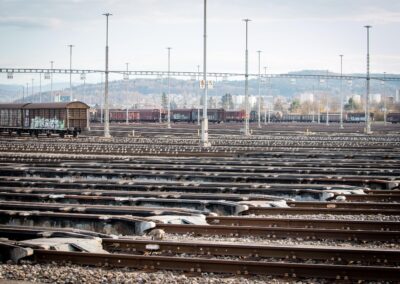
«MODERATE» ADJUSTMENT OF THE TRACK ACCESS CHARGE: A FATAL BURDEN FOR RAIL FREIGHT TRANSPORT
The Federal Office of Transport (FOT) has announced that it will increase the train path price for rail transport by 2.1 per cent from the beginning of 2025. This measure is aimed at meeting the legal requirements for cost recovery, but carries the risk of placing a considerable burden on rail freight transport and jeopardising the modal shift to rail.
That’s the point:
- Track access charge increase unacceptable
- Economic crisis, rising energy prices, global downturn make rail freight transport more expensive
- What we can do for the shift to rail transport
Our opinion on this is clear: we reject an increase in track access charges for freight transport. With an increase of 2.1%, it is also extremely misleading to describe the adjustment as “moderate”, as it could lead to fatal and irreversible consequences. Against the background of traffic losses in domestic, import, export and transit traffic as well as the significantly more favourable track access charges in Europe, a price increase is unacceptable.
Economic background and challenges
The European economy is currently struggling with a profound crisis, which is being exacerbated by the ongoing conflict in Ukraine, rising energy prices and the global economic downturn, particularly in China. These factors are leading to a decline in the exchange of goods and are having a significant impact on the transport sector.
Since mid-2022, we have seen a continuous decline in rail freight transport volumes in Europe. The average 10% increase in the cost of rail traction is driving many companies to shift more of their freight to the road. The umbrella organisation of combined transport providers UIRR reports a decline in rail freight transport of around 15% for 2023, while road transport has only fallen slightly.
Cost increases and their toxic effect
In this difficult environment, the planned price increases for energy and the wear factor are having a disproportionate impact on freight transport. The wear factor will be increased by 9% from 0.33 to 0.36 CHF/BTkm, and a decision on how energy costs will rise will be made in July.
The reason given for the increase in the basic wear and tear price is the rise in weight-dependent marginal costs, although the calculation of these costs is not transparent and is based on the infrastructure expansion standards for passenger transport. This price component, intended as an incentive for the procurement of rolling stock that is gentle on the track, does not accelerate the replacement of railway carriages with their long service life of 2–3 decades. The incentive is too low to cover the additional costs for low-wear rolling stock, which significantly increases the costs for rail freight transport and reduces its competitiveness.
Conclusion
Although a 2.1% increase in the track access charge is intended to meet the legal requirements for cost recovery, it will lead to considerable additional costs for freight transport. This measure could undermine efforts to shift traffic to the railways and further exacerbate the economic burden in an already challenging environment. It would be desirable for rail freight transport, which suffers from the high expansion standards of passenger transport in the mixed operation of passenger and freight transport, to be fundamentally relieved. This is the only way to make rail freight transport competitive and successfully drive forward the mobility transition.

RailCom: Promoting a competitive railway system through innovation and transparency
Patrizia Danioth is a lawyer and notary and has been President of RailCom since 2013. In this interview, she gives us an overview of RailCom’s tasks, her position on the draft legislation for freight transport and talks about the future mobility infrastructure (MODI).
That’s what it’s all about:
- RailCom ensures non-discriminatory access to the railway network
- Promotes competition in the railway system
- Supports the strengthening of the EWLV
- Access to data for greater transparency and innovation
Mrs Danioth, what is RailCom responsible for?
RailCom ensures non-discriminatory access to the railway network, CT transhipment facilities and local delivery services. In this way, RailCom contributes to a competitive Swiss railway system. RailCom also expresses its views on issues that fall within its remit as part of the legislative process. This is the case with the current draft legislation on the future of Swiss rail freight transport.
What is RailCom’s position on the current draft legislation on the future of Swiss rail freight transport? Where do you see a need for action?
RailCom supports the strengthening of single wagonload transport and the further development of multimodal transport chains. However, RailCom identifies two critical aspects in particular in the draft law on Swiss freight transport, which need to be regulated in a coherent manner with existing legislation.
What are the critical aspects? What requirements would the draft legislation have to fulfil in order to be consistent with existing legislation?
Firstly, the state subsidisation of single wagonload transport must be competition-neutral. Block train transport, which is self-sufficient, must not be cross-subsidised by the subsidised single wagonload transport. Such a distortion of competition must be prevented with the present draft law on Swiss freight transport. Be it that the provider of single wagonload transport makes a financial, legal and organisational separation between the self-economic services of block train transport and single wagonload transport. Be it that stricter requirements as well as control and sanction options effectively prevent cross-subsidisation.
The aim of the proposal is to promote an innovative offering in single wagonload transport with a high level of customer orientation. Fair framework conditions are essential for this.
Secondly, existing legislation in the railway sector and in freight transport stipulates that if a company receives financial support from the state, it must make its services or access to its facilities available to third parties on a non-discriminatory basis. Although the draft law on Swiss freight transport provides for non-discriminatory access to single wagonload transport services in principle, it does not yet sufficiently specify this requirement. This is shown by a comparison with the legislation on the promotion of CT transhipment facilities or the law on underground freight transport: For example, the legislator regulates the rights and obligations of the operators of CT transhipment facilities in more detail than those of the network provider in single wagonload transport.
With MODIG, a bill is being drafted to ensure that the infrastructure and services of public and private transport can be optimally operated and utilised thanks to a better flow of information. The mobility infrastructure (MODI) should one day enable the various players to be networked and data to be provided and exchanged. What does RailCom think of MODI?
Data and data exchange are an indispensable prerequisite for mobility. Alongside rail and other transport facilities, data therefore forms a system-relevant infrastructure. Data is also a prerequisite for the utilisation of infrastructure: Data that is relevant for access to the rail network, CT transhipment facilities and last-mile services, for example, must be available to all users in a transparent and user-friendly manner and be easy to find. The data must be made publicly accessible in a non-discriminatory manner, i.e. complete, correct and free of contradictions. MODI can make a significant contribution to this.
MODI and open data in general also strengthen non-discrimination through increased transparency, equal treatment and the possibility of third-party participation. Open data thus promotes economic efficiency and customer-orientation by strengthening competition. The potential for innovation in the sector is increased. The privately operated website www.puenktlichkeit.ch, for example, allows insightful comparisons to be made on the punctuality of trains.
Mrs Danioth, thank you very much for this interview!
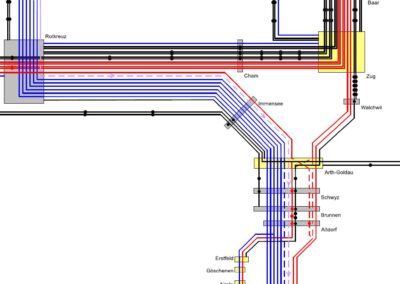
Flexibilisation of train path protection for freight transport
That’s what it’s all about:
- Network utilisation concept and plan (NNK/NNP) secure train paths for goods trains in the long term
- Unused freight train paths – demand from passenger transport
- Motion 23.4259 Method for determining train paths for long-lasting construction sites
- Temporary flexibilisation only with binding agreement to solve the bottleneck
Network utilisation concept and plan (NNK/NNP) secure train paths for goods trains in the long term
As part of the «Financing the railway infrastructure» bill in 2013, infrastructure expansion targets for freight transport were defined in Art. 48a lit. b of the Railway Act (EBG). These include improvements for domestic, import and export traffic as well as improving the availability of train paths. As part of the draft revision of the Freight Transport Act, the so-called network utilisation concept and the network utilisation plan were introduced in 2015 as a means of securing available freight train paths. With these instruments, the long-term expansion and utilisation planning of the railway infrastructure is designed to ensure the availability of a minimum number of train paths per hour and direction on the various network sections for freight and passenger transport. The service concepts and rolling timetable planning must be developed along these available train paths. If, through skilful capacity planning in the timetable procedure, more train paths are ultimately available in the annual timetable than provided for in the NNK/NNP, they are also available to the train path allocation body for allocation.
Unused freight train paths – demand from passenger transport
As freight transport, unlike passenger transport, cannot be planned in the long term and depends on current market conditions, secured freight train paths are regularly not utilised. This is unproblematic as long as there are no conflicts with passenger transport. However, in the case of construction sites, as is regularly the case on the Swiss network due to ongoing expansion and necessary maintenance work, conflicts are practically inevitable. If freight train paths are actually not used in such constellations, the passenger transport industry and the cantons are understandably very unhappy.
Motion 23.4259 Method for determining train paths for long-term roadworks
With motion 23.4259, NR Cottier FDP/NE is asking the Federal Council for a method to improve the allocation of train paths in the event of long-term construction sites. The aim is to create the possibility of allocating unused freight train paths to passenger transport for the duration of construction sites. The Federal Council is asking Parliament to reject the motion, as the desired flexibility is provided by the current planning system. Unused freight train paths can be allocated to passenger transport.
Temporary flexibilisation only with a binding agreement to solve the bottleneck
The petitioner’s concern is understandable. The VAP has also signalled to the cantons on various occasions that it will not refuse the desired flexibilisation of train paths. However, this cannot mean a fundamental renunciation of securing freight transport routes à la longue. Rather, an appropriate solution must be agreed for each conflict on a case-by-case basis. In the case of structural conflicts in particular, for example as a result of unforeseen expansions in passenger transport services that are not of a temporary nature and therefore preclude the future safeguarding of the freight train path concerned, a corresponding structural solution must be agreed as part of the next expansion phase. However, this is legally difficult to implement, as it is Parliament that decides on the expansion stages and credits and not the affected cantons and industry representatives.
Possible solutions are currently being sought at a round table, using the example of the service between Neuchâtel and Geneva. The VAP will participate as a representative of customers, who can also order train paths, in an endeavour to find balanced solutions.
At the end of 2023, the FOT also started work on the evaluation of NNK and NNP. The aim is to evaluate the instruments that have now been in use for a considerable period of time with regard to any need for improvement. The VAP is actively involved in this working group.
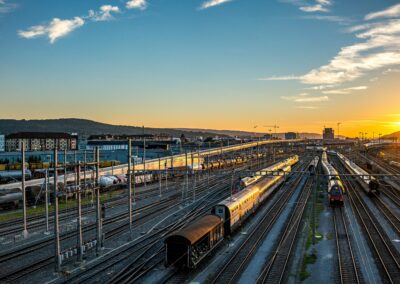
Focus RailCom: presentation of key people
This is the issue:
- The Commission guarantees non-discriminatory access
- Who is behind the Commission? We would like to introduce you.
RailCom guarantees non-discriminatory access to Switzerland’s rail network, combined transport transhipment facilities and local freight services. The Commission is actively committed to an open and fair market access policy in order to promote healthy competitiveness and increase the efficiency of the rail sector.
In this blog post, we introduce the staff who are committed to RailCom.
Chairmanship:
- Chair: Patrizia Danioth Halter, lic. iur., attorney-at-law and notary, LL.M., Altdorf (UR)
- Vice-Chairman: Markus Kern, Prof. Dr. iur., LL.M., Professor of Public, Administrative and European Law at the University of Berne (BE)
Members of the committee:
- Cesare Brand, lawyer, Forel (FR)
- Anna Ciaranfi Zanetta, Lawyer, Department of Finance and Economy of the Canton of Ticino, Dalpe (TI)
- Barbara Furrer, Dr. iur., attorney-at-law, Head of Legal Services, DHL Express (Schweiz) AG, Hedingen (ZH)
- Manfred Haller, EMBA, independent consultant, Unterkulm (AG)
The secretariat provides professional and technical support to the committee. It follows the Commission’s instructions. It is administratively attached to the General Secretariat of the Federal Department of the Environment, Transport, Energy and Communications (DETEC). Its members are as follows:
Head:
- Christof Böhler, M.A. HSG International Relations
- Deputy: Melissa Rickli, lic. phil. hist.
Staff members:
- Ana Dettwiler, Lawyer, Legal Affairs
- Ursula Erb, Doctor of Economics, Market Monitoring
- Andreas Oppliger, lic. phil. nat, Market Monitoring
- Katrin Suter-Burri, Ph. ETH, Communication, Agenda and Research
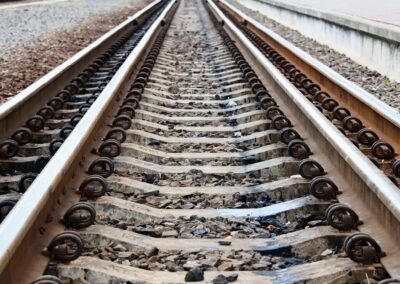
Train path price revision 2025–2028: Price increase is unfounded
The Federal Council plans to increase the train path price in freight transport from 2025. In detail, it wants to raise the basic price for wear and tear by almost 20%; on the grounds of uncovered weight-dependent marginal costs in this area. We reject this unjustified price increase. It accelerates the ongoing modal shift to the roads and contradicts the Federal Council’s modal shift objective.
This is the issue:
- Track access charges not derived transparently
- Traffic losses prohibit price increases
- Respect the legal principle of cost recovery and the polluter pays principle
- Incentive for low-wear freight wagons reversed
- Make infrastructure managers more accountable
Track access charges not derived transparently
The explanatory report of the Federal Office of Transport (FOT) of June 2023 is neither transparently designed nor comprehensibly justified. The reasons for the current determination of the train path price remain completely unclear. Since the FOT refers, among other things, to falling train path revenues, the impression is created that this is a hidden cross-financing of the SBB. Against the background of the “Sustainable Financing of SBB” bill and the reduction of the contribution margin in SBB passenger traffic envisaged therein, this justification is unreasonable for the representatives of freight traffic. Our negative response to the above-mentioned bill can be found in our hearing response of 7 March 2023 and in our blog post “SBB should take responsibility instead of 3 billion financial package”.
Traffic losses prohibit price increases
A price increase is unacceptable in view of the traffic losses in domestic, import, export and transit traffic and the significantly cheaper train path prices in the European environment. Shippers have been exposed to drastic price increases for years, especially in wagonload traffic. These are justified by exogenous factors such as train path prices.
Respect the legal principle of cost recovery and the polluter pays principle
The FOT justifies the price increase with the legal principle of cost recovery. This would be upheld even in the event of a price reduction in freight transport. On the contrary, a price reduction is in line with the polluter-pays principle, since freight traffic pays the standard marginal costs of an averagely developed network, which is mainly geared to the needs of passenger traffic. Shippers do not notice the efforts made by the infrastructure managers to build and maintain the infrastructure more cheaply.
Incentive for low-wear freight wagons twisted
The so-called wear factor is supposed to serve as an incentive to use low-wear rolling stock. In the meantime, the opposite is the case: the Federal Council is encouraging the industry not only to pay ever higher track access charges, but also to invest additional financial resources in low-wear rolling stock.
Holding infrastructure managers more accountable
The presented train-path price revision goes easy on the infrastructure operators. As representatives of the siding and terminal operators, who are directly affected by the planning, construction and maintenance costs of SBB Infrastructure in centralised sidings, we observe considerable inefficiencies and an almost shameless handling of financial resources. This is most likely equally true for the public network. The federal government should therefore also oblige infrastructure managers to contain costs.
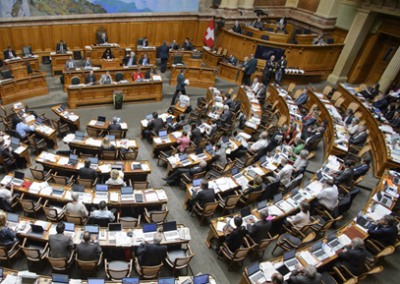
Winter session 2022
On 6 December 2022, the Council of States adopted two motions in the second instance. They are important for modal shift in transit, but also concern the Basel-North ports route, which is central for import and export traffic. We at the VAP support both motions and encourage the extension of state support to conventional rail freight transport.
This is what it’s all about:
- Council of States adopts two motions in favour of the freight corridor through Switzerland
- We at the VAP support the contents of the motions – and set priorities
- Because conventional rail freight transports are currently still being excluded
Promotion of the freight corridor through Switzerland
With the motion 22.3013 «Strengthening the attractiveness and competitiveness of the freight corridor through Switzerland», the Federal Council is to specifically extend the support measures in transit to certain regions and groups of goods. We at the VAP support this motion. However, it excludes conventional rail freight transport and its untapped potential. This deficiency should be corrected as soon as possible.
Article 8 of the Freight Traffic Shift Act (in german) allows the promotion of all – i.e. transalpine – freight traffic in transit. Accordingly, the Federal Council should be instructed to promote all freight traffic and to provide the promotion instruments consisting of financial support, quality monitoring and the expansion of access routes for conventional traffic as well. For these, too, the targeted extension of support measures to certain regions and freight groups makes sense. By sticking to the dogma of «combined transport», Switzerland is missing out on interesting opportunities for an additional shift from road to rail.
The Federal Council should design the support instruments in a technology-neutral way and extend them to all freight transport in transit, regardless of the type of production.
Expansion of the Wörth-Strasbourg Neat feeder road on the left bank of the Rhine
Motion 22.3000 «Continuation of the successful modal shift policy and guarantee of supply security thanks to expansion of the Wörth-Strasbourg corridor on the left bank of the Rhine» calls on the Federal Council to take care of the electrification and upgrading of the affected section of the line to NEAT standards. It is considering the possibility of funding from Switzerland.
We in the VAP support this motion, as we did with motion 20.3003 «State treaty for a Neat access route on the left bank of the Rhine». An efficient routing of the flat railway in the northern approach to the NRLA is urgently needed in terms of supply security, alternative capacity for construction phases, punctuality and quality. Electrification and the introduction of the NRLA standard on the affected section of track, together with the simultaneous expansion of the Kannenfeld and Schützenmatt tunnels to 4 metres, will allow an initial substantial increase in capacity on the northern approach to the NRLA.
Click here for the SDA news item of 6 December 2022 (in german)
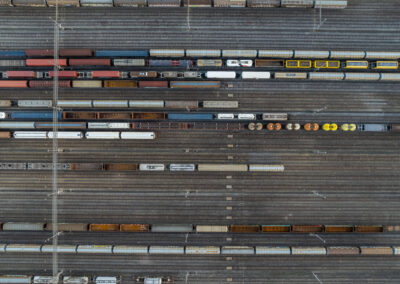
«BAHN 2050» – A CRITICAL LOOK AT THE FEDERAL GOVERNMENT’S LONG-TERM PERSPECTIVE
The Federal Council wants to further strengthen the railways in the long term. To this end, it has revised its long-term rail strategy. It is now focusing on improved access to the railway and more capacity on the east-west axis with new multimodal transhipment platforms and facilities for city logistics. Here is a critical appraisal of this perspective.
With a view to future expansion steps of the railway infrastructure, the Federal Council has adapted its long-term rail perspective from 2012 and published details from the meeting of 22 June 2022. Up to now, the Federal Council has concentrated primarily on eliminating bottlenecks and increasing frequency. With the upcoming expansion steps within the framework of the BAHN 2050 perspective, it wants to improve the rail service primarily on short and medium distances, for example with additional S‑Bahn services and an upgrade of the suburban stations. In this way, it takes into account the fact that the greatest potential for modal shift to rail lies within the agglomerations and in connections between regional centres and agglomerations.
Promoting modal shift in freight transport
In freight transport, access to the railway is to be improved and capacities on the east-west axis increased. This will be achieved with new multimodal transhipment platforms and facilities for city logistics. With the targeted modal shift, the Federal Council wants to strengthen its strategy for achieving the climate goals and better coordinate spatial and transport planning. This aspiration is expressed in its vision: «Thanks to the efficient use of its strengths, the railway makes a major contribution to the 2050 climate goal and strengthens Switzerland as a place to live and do business».
Conflict of goals: free choice of transport
The Federal Council defines one of the main goals of RAIL 2050 as increasing the share of rail in the modal split for both passenger and freight transport. This goal contradicts the constitution, which guarantees the free choice of transport mode for domestic traffic. There is also a contradiction with the Federal Council’s previous goals, in particular with goal 7 of DETEC’s 2040 orientation framework, «Future Mobility». According to this, transport users in Switzerland are free to decide which mobility offers they use and combine.
Intramodal competition and market-based offers
For us at the VAP, the modal split is the result of a well thought-out infrastructure, transport and spatial planning policy. As the voice of the shipping industry, we advocate favourable framework conditions that boost intramodal competition on the railways and ensure customer orientation and innovation with market-based offers. In order for such offers to develop their potential, sufficient capacities on the network with high-quality and inexpensive train paths as well as sufficiently well-developed logistics locations are necessary. This is the only way to increase the share of rail freight transport in the modal split. We therefore warn against ideas of further networks and coordinated system train paths by SBB Cargo. These hinder the desired intramodal competition and have a correspondingly negative effect on customer orientation and innovation.
Ensuring connection to Europe
We welcome the Federal Council’s focus on short and medium distances. However, it ignores the complex potential of international transport. This is regrettable. In our opinion, the BAHN 2050 perspective should provide for a favourable connection of the Swiss railway network to the international corridors and the Rhine ports as well as southern ports in the destination area. The Federal Council is explicitly called upon to meet this requirement by Motion 22.3000 «Continuation of the successful modal shift policy and guarantee of national supply security thanks to the expansion of the Wörth-Strasbourg Neat feeder line on the left bank of the Rhine» and Motion 20.3003 «State treaty for a Neat feeder line on the left bank of the Rhine».
A clear yes to digitalisation
We consider the intention to consistently use efficiency gains through automation and new technologies as positive, as well as the goal of flexibly and optimally networking rail services with other modes of transport and services as part of overall mobility. In addition to the aforementioned multimodal transhipment platforms, the framework and market conditions for freight railways play a decisive role here. In addition to digital automatic coupling (DAK), this includes open data and booking platforms in particular. With their help, data from the entire value chain is recorded and exchanged transparently so that rail freight customers can easily book their consignments and track the flow of goods in real time.
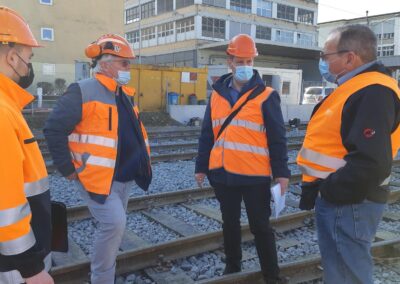
Successful cooperation
Swiss Post has renewed its switches in Mülligen with the help of SBB Infrastructure and Vanoli AG Zofingen. As a VAP member, Swiss Post was able to count on the support of the experienced Hanspeter Rutz, a member of the VAP consulting team. Click here for the full report (in german, french or italian).
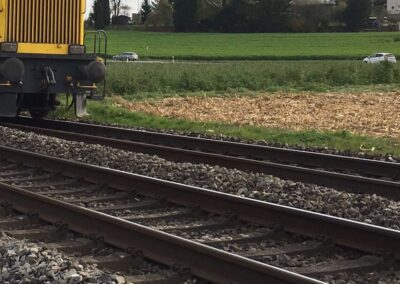
Revised train path price in 2021
The 2021 revision of the track access charge will lead to a reduction of CHF 30 million in freight transport. After the 2013 revision brought an increase of CHF 25 million, the cost block for freight railways is now back at the 2013 level. Accordingly, the costs for rail freight transport in the market should fall. Due to the newly introduced bonus for trains with a length of over 500m of 1Rp/train km, there is an incentive for the formation of long trains and thus the use of fewer train paths.
Noise bonus still granted
The noise bonus remains in place, but undergoes two negative changes: The bonus will be reduced from 2 Rp/km per axle to 1.6 Rp/km per axle. In addition, the bonus will only be granted if the goods train concerned contains only low-noise wagons. A single freight wagon equipped with grey cast iron brake blocks leads to the loss of the noise bonus for the railway undertaking (RU). The RUs have a responsibility not to classify any wagons with grey cast iron brake blocks, otherwise they will be liable to pay damages to the keepers of low-noise freight wagons. The noise bonus amounts to around CHF 30 million per year. If it were to be further reduced or cancelled, the compensation for the 2013 train path price surcharges granted with the 2021 train path price would be lost.
Criticism remains unheard
The fundamental criticism of the FOT’s train path pricing model by the industry associations once again went unheard. The definition of the standard marginal costs in the various route categories is not fair to the originator. What is needed is a differentiation of the route categories according to passenger and freight traffic. This is because each route category is primarily defined, built and operated according to the needs of passenger traffic. Freight traffic, with its comparatively modest train kilometres and demands on the network, does not define the standards and thus the so-called standard marginal costs per category in the mixed operation of passenger and freight traffic. Nevertheless, it must bear them in full. This is not fair to the polluter. Instead, a lower approach to the standard marginal costs should be applied to freight traffic in each category, in accordance with its demands on the standard of development.
A step in the right direction
After all, the last reduction in the train path price has its origins in the signal boxes and the costs for operations management. This may be interpreted as a first step in the right direction of increased polluter-pays fairness.